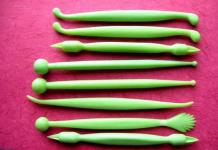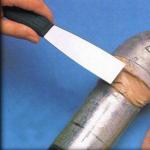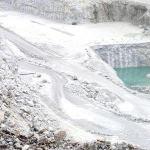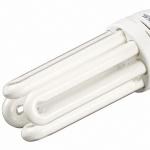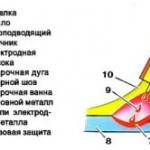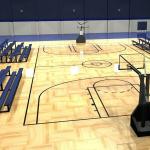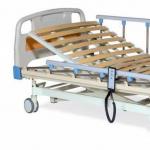The assembly of the railing for the stairs is completed by installing the handrail. What can be the fastening of the handrail, how to do it correctly, reliably and imperceptibly, not everyone knows. Some common ways for wooden and metal stairs will be described here.
Fastening the handrail to the balusters of a wooden staircase
It turns out that wooden railings are the most difficult to make. This is because there are many different ways and techniques of working with wood and there are almost no ready-made solutions, since each staircase is individual, has its own characteristics. For example, fastening a handrail to balusters can be done using dowels, self-tapping screws, nails, bolts, special ties (zip bolt), glue. In addition, railings can be “attached” directly to balusters and poles, but there are options with an additional bar, which is sometimes called a “pillar”. And all of these are the “correct” ways to connect the racks to the handrail. Here's how you can do it and we'll talk in this section.
First of all, cut off a piece of the handrail of the desired length. It can be a fragment from one support column to another, a piece for the entire span - from the upper / lower column to the moment of rotation. It all depends on the design of the stairs. If there are joints between two fragments, they must be well processed, achieving a perfect match. Then the handrails for the street must be coated with protective impregnations, and then painted / varnished. After that, you can already deal with the issues of attaching the handrail to the stairs.
How to cut balusters for handrail installation
After installing the balusters on the steps, their tops are at different levels, and you can’t install a handrail on them without trimming - it doesn’t lie like that. To install the support rail on the stairs, it is necessary to cut the upper part of the uprights at a certain angle. This angle is determined by the steepness of the flight of stairs and does not need to be calculated. It is defined "on the spot".

To find the angle of cutting the balusters, you can use a thread stretched between the support posts. We tie it at the same distance from the tops of the pillars, which are installed at the top and bottom of the span. Where, as planned, the lower boundary of the handrail will pass. Using this stretched thread with a pencil, we transfer the line to the tops of the racks. Instead of a thread, you can use and you can also temporarily fix the guide (any flat bar).

This is how it should turn out - the stair railing is ready for the installation of handrails
We got the line, now we saw off the tops of the columns on the stairs strictly along it. Next, you can continue to mount the handrail on balusters or poles.
Let me give you one piece of advice: if for the subsequent installation of the railing you need to drill holes for dowels or studs, it is better to do this before trimming. It's easier to find the center, it's easier to keep the drill perpendicular. After the holes are made, you can take a saw / jigsaw and file it along the marked markings of the rack.
Connection of balusters and railings with dowels and threaded studs
Consider one of the traditional ways: fastening the handrail with dowels or studs. For this type of connection, matching holes must be made in the handrail and stair railing posts. If you install studs, they can be screwed into the holes made in the center of the balusters, set the handrail in the position in which it should stand. After checking if everything is right, walk along the handrail, tapping your fist over each baluster. The protruding ends of the metal studs will leave a mark on the back of the handrail. Remove the handrail, mark the resulting marks for reliability with a marker / pencil. Now you can drill holes. With this method of marking the handrail, there are almost no problems with its “landing” in place.
The second option for marking the handrail for the installation of studs and dowels is carried out before they are installed in the balusters. First of all, we put the cut piece of the handrail in place. Then we mark with a pencil on both sides where the balusters are installed. Before marking, we check the distance between adjacent posts below and near the handrail. If they match, everything is fine, we put marks, if not, we correct the position of the rack and only then we make marks. Adjustment is needed so that all ladder supports are vertical. This will make the railing more secure.
After all the balusters are marked, remove the handrail. On the reverse side are our marks. Between the pairs of lines that outline the baluster, we draw diagonals. Put a mark at the point where they intersect. Here it will be necessary to drill a hole for a dowel or a hairpin. Similarly, we find the centers on the balusters (if there are no holes in them yet). As you understand, with this method of marking the handrail for the railing, problems can arise - the slightest inaccuracy and the handrail does not fit into the rack. The good news is that the baluster can be moved within certain limits. Until it is fixed, there is a certain freedom, and it can be used when installing the railing. Just move it so that the spike enters the groove. In general, you know how to attach a handrail to dowels.
To make the installation of the railing more reliable, in addition to dowels or studs, you can coat the connection with glue. This will make the structure more rigid, extend the service life without backlash.
With an auxiliary bar - a railing
Agree that the easiest way to install a handrail on balusters is through screws or nails. What stops such a decision? Too unsightly result in the form of fastener caps that spoil the whole look. But there is a very similar way to ensure a good looking stair railing. An auxiliary bar is used, which is also called a slat.
The auxiliary bar is cut out with a spike, which mirrors the shape of the groove at the bottom of the handrail. With its even side, it is placed on sawn balusters, fixed through (self-tapping screws or nails - your choice). Don't forget to check the distances between adjacent racks.
Then the upper part of the underlay is smeared with glue and the handrail is “planted”. All. No traces of fasteners on the front of the handrail, everything is holding. The only thing to consider is that the height of the handrail turns out to be somewhat larger, since more thickness is added and the auxiliary plank (if the plank is wooden, this is at least 2-3 cm).
There is another way to fasten the handrail to the underframe - with small nails or self-tapping screws from below, at an angle. But with such a mount, hats are visible. They can be disguised in one of the known ways, but it takes a long time ...
The easiest way is to fasten with screws
As you know, over time, wooden railings “loose” due to the fact that they stagger under load, the wood fibers are crushed, and play appears. To reduce the possibility of backlash, when fastening through a lath, two or more self-tapping screws / nails can be used for each baluster. So the fastening of the handrail will be more rigid.
Also, for greater reliability, the bar can be made of metal. Any thin metal will do. Be it steel or aluminum. But then it will be necessary either to cut the bar to the dimensions of the recess in the handrail, or to modify the groove so that the handrail fits well on the structure. And one more thing: if the bar is metal, you need to find a universal glue that glues wood with metal well. This fastening of the handrail on the stairs is simple, beautiful, reliable. Suitable for those who decide to make a handrail for the stairs with their own hands for the first time.
On spikes of various shapes
It is possible to install a handrail made of wood without metal fasteners: on spikes and glue. Spikes are cut out at the top of the balusters. Under them, recesses of the same shape are formed in the handrail. The shape of the spike / groove - any. It can be a rhombus, a rectangle, a circle, an oval. The main thing is that the spike and groove match perfectly. This can be achieved by making a template and repeating it exactly on each fragment. The minimum spike height is 2.5 cm, so the height of the handrail cannot be less than 4.5 cm.
After a spike is formed on each baluster, and a groove is cut in the appropriate place on the handrail, they are glued. When installing the handrail on the balusters, they can be slightly shifted to align the holes. You can use the installed handrail after the glue has dried (time is on the package).
Connection of handrail and support post
Often the handrail does not go over the post, but is connected to its side face. How to join the handrail and the pole in this case? The easiest way is after cutting the handrail at the right angle, fasten it to self-tapping screws or nails driven in at an angle. The disadvantages are obvious - fastener caps are visible.
There is another way - to use a zip bolt, which consists of two movably connected studs and a gearbox. For its installation, a technological hole is required, which is made at the bottom of the handrail. It is then closed with a plug to match the wood and it becomes almost invisible. The second plus of such a connection: it can be tightened (to a certain extent), if suddenly a backlash appears.
Even under the zipbolt, you need to drill holes for the studs - one each in the post and in the handrail. The technological hole is usually made in the handrail. It is positioned so that it is possible to tighten the thread under the gearbox (the length of this thread is usually 10 mm). The depth of the holes is according to the size of the studs (from the junction to the edge), the diameter is 1-2 mm less than the diameter of the stud.
Studs are installed in the drilled holes. It is screwed into the pole, it is simply inserted into the handrail. A gearbox is installed in the prepared technological hole, in which there is a hole for a hex key (6 mm). We unfold the gearbox so that it is convenient to use the key. Turning the key, tighten the thread, pulling the handrail to the post. This must be done after the balusters are connected to the handrail. By attaching the handrail to the post, we can assume that the railing is installed.
Installation of a handrail on prefabricated metal fences
In general, the assembly of handrails from metal (stainless, nickel-plated, chrome-plated) pipes is similar to a designer. There are pipes of different diameters, decorative elements for them, and a whole range of different fasteners. From all these details, the railing is assembled. That is why they are called "combinations". When deciding how to attach handrails to metal balusters / posts / posts, your task is to choose those elements that best suit your task or you like more than others.
To connect metal racks / balusters with a handrail, there are special tips that are attached to a round / square / rectangular pipe on one side, and to the handrail on the other. There are different types of models. You only need to find the most suitable, choose the right one: according to the size of the racks and the type of handrail.
In metal prefabricated fences, handrails can be different:
- round metal pipe;
- profile (rectangular, square) metal pipe;
- plastic handrail (round, oval or original shape);
- wooden of any profile.
Under each of these handrails there is a mount, and usually more than one. Choose what you like. They are easy to fix with clamp bolts. But, for reliability, and if the thickness of the metal allows, all joints of two metal parts can be welded. - a tricky thing, but if you know how to handle a welding machine, there is nothing impossible in this. Welding takes more time, but such a fastening of the handrail will be very reliable.
When connecting the elements of a metal staircase with plastic or wood, you must use the fasteners recommended by the manufacturers. Additionally, you can glue the joints with universal glue. True, in the case of stainless steel, this is of little use: the grip will be very low. But still…
Fastening a handrail to a welded or forged stair railing
A wooden handrail is usually placed on a forged or welded fence. In its lower part, a cut is made according to the size of the upper jumper of the finished fence. The depth of landing of the handrail is about 2 cm. It is possible more or less - it depends on the desire. The railing is connected to the handrail with self-tapping screws, which are screwed through the holes in the upper jumper. At the same time, it is important to choose the length of the fastener: it should be slightly (at least 5 mm) less than the height of the handrail so that the screw does not stick out on the surface.
In this case, the installation of the handrail on the stairs is simple:
It is also possible to glue a wooden handrail to metal welded or forged railings. When choosing an adhesive, you need to look so that it can connect wood and metal. For outdoor stairs (on, for example), you also need to pay attention to the operating temperature range. Otherwise, there are no difficulties:
- spread glue according to the instructions;
- press the parts, fix with clamps;
- leave until the glue dries;
- remove clamps.
Both of these methods can be used to securely attach a handrail to a steel ladder. One does not interfere with the other.
Methods for attaching the handrail of the stairs to the wall
A handrail is attached to the wall if the width of the steps on the stairs exceeds 120 cm. The second handrail is made of the same material and the same shape as on the balusters, but it is attached to the wall.
For mounting the handrail on the wall, there are a number of mounts - brackets - for different profiles (round, oval, figured). On one side of the fastener there is a round or square fragment with a flat surface and holes made in it. This part is mounted on the wall. We select fasteners depending on the material from which the wall is made. We use self-tapping screws if the walls are wooden, dowels for walls made of concrete and brick, and special dowels for fastening to lightweight concrete.
We select the number and size of fasteners for installing a stair handrail on a wall based on reliability considerations. Manufacturers make at least four holes on each bracket. Here are four screws / dowels / nails for each and put. When choosing a length, it is better to proceed from the considerations "the longer the better." Still, a solid load can fall on the wall rail, so it’s better to be safe than to fly down ...
The second part for wall mounting of stair railings - where the handrail itself is attached - can be different. Under round pipes there can be a ring of a certain diameter, under rectangular or square handrails there is usually a flat area. There are also holes in this part of the stair handrail bracket so that the railing can be fixed. And in this case, the number of fasteners should be equal to the number of holes (for the same reasons).
There are brackets for wall mounting handrails with different angles. They are chosen based on their own ideas about the convenience and the planned height of the support. There are also telescopic models that allow you to set the distance to the wall and / or the angle of inclination. There are also end wall brackets, which, along with fixing the edges of the handrail, also decorate them decoratively.
The number of brackets depends on its handrail length. Usually, one element is placed at the edges, and between them is a calculated number, with a distance of 40-60 cm. The lower the bearing capacity of the wall, the more often we install wall holders for railings.
One of the main elements of the staircase design is its fencing. It performs two functions: protective and decorative, and consists of balusters, main support and intermediate posts, protective screens and handrails. Railings provide a safe movement of a person along the flight of stairs, give him support when walking and prevent falling over the perimeter of the stairs. To properly install the fence, you need to know how to fix the balusters and railings, depending on their type and material of manufacture. Let's try to understand this issue.
Balusters - an important element of the stair railing
Balusters are vertical supports on which a handrail is laid. They are installed directly on the steps, or attached to bowstrings or stringers. The shape of the balusters can be different and depends on the interior of the room, the design features of the stairs and design ideas. They are able to decorate even the most nondescript flight of stairs, and they make balusters from:
- tree;
- metal;
- natural or artificial stone;
- concrete;
- gypsum;
- glass, etc.
Often there are stair railings, in which there is a combination of two or three types of materials that are in harmony with each other. It is on them that it largely depends on how to attach the balusters to the stairs, which installation option is better to choose.
Requirements
In order for the stair railing to be reliable and safe, when installing it, it is necessary to ensure compliance with some mandatory rules and conditions:
- the clear distance between the balusters must be at least 150 mm;
- the safe height of the railing can be at least 900 mm;
- fastening of the supports must be done at two points - to the handrails and the staircase structure (steps, bowstrings, stringers);
- handrails should be as comfortable and smooth as possible, but not slippery. Near the wall, they can be attached directly to it without installing balusters.

The main protective function of the railings is assumed by the support posts - lower and upper ones, therefore, their fastening must be approached more responsibly. Although the installation of intermediate balusters should be taken no less carefully. It is necessary that the fence withstand a person weighing 100 kg leaning on it.
The railing installation process consists of the following steps:
- installation of extreme (upper and lower) support pillars;
- marking the locations of balusters. To do this, you can use a thin but strong cord, or a laser level. Do not forget that markup accuracy is extremely important and avoids unnecessary problems;
- drawing center lines in the center of the balusters with a pencil or marker;
- preparation of the upper ends of the balusters. They must be sawn off in accordance with the slope of the flight of stairs. The lower ends are filed only if the vertical supports are installed on top of the bowstring or the fastening of the railing to the stairs has an individual design.
wooden stair railing
The main load-bearing elements of the fences can be attached to the steps with ordinary nails, but such a design will very quickly begin to loosen and become unusable after a short period of time. There are three main ways to make a more reliable fastening of the railing; handrails are mounted identically to the balusters. Fastenings are carried out:
- on stilettos;
- on dowels;
- on self-tapping screws.

When installing the railing on metal studs, a hole is drilled in the middle of the lower end of the wooden baluster with a depth of no more than 80 mm. Its diameter is usually 12 mm.
It should be noted that the studs, in order to avoid rust, must be galvanized. A pin is inserted into the hole so that it protrudes 5-7 cm beyond the surface. Using special glue, they are fixed in the desired position and await its final setting.
Installation of balusters on dowels, which are rounded wooden spikes, is carried out as follows:
- at the lower ends of the balusters and on the bowstring or steps, larger holes are drilled than for metal studs;
- dowels are inserted into the finished recesses, using glue identical to PVA for fastening;
- a baluster is placed on the dowels, filling the pre-prepared holes with glue;
- check the verticality of the racks using a level or plumb line and leave them for 2-3 hours until the glue has completely set;
- start installing handrails.

The easiest way is to install wooden balusters on self-tapping screws, which must be made of stainless steel. A self-tapping screw is screwed into the vertical support at an angle so that its tip protrudes slightly beyond the end of the baluster. Then it is installed in the desired position, and the self-tapping screw is screwed into the ladder structure to the end so that its cap is slightly recessed. In the future, the recess will not be difficult to seal with putty or wax.
Feature of fastening metal railings
The metal railing is combined with almost any material from which the staircase is made. It can give it severity, make it elegant or massive, give a touch of mystery or super technology. Forged railings are sophisticated and expensive, so the question of how to fix balusters and railings will be taken care of by specialists.
A simpler option is vertical stainless steel supports or with a special protective coating. Their package includes universal fasteners suitable for wood, or glass and metal. These can be hidden screws or fasteners with protruding spectacular elements.
Glass balusters
Glass elements of fences in modern interiors are quite popular. Despite the apparent fragility, they have sufficient strength and reliability. Glass is attached to any base using metal hinges or nozzles. Protective screens made of glass are installed in certain profiles.

There are many more different materials from which railings are made, but we have considered the main options for their fastening above. And the nuances appear, add up and are resolved in each case individually.
The most common types of stair railings are wooden, metal, forged, cast and combined. All elements of the staircase fencing (railings, handrails and balusters) are usually made in the same style and should be in harmony with the appearance of the steps and side stringers. There are many ways to fasten the railing of stairs, and you will receive detailed information about the most commonly used of them in this material.
Despite the fact that railings are considered a minor detail of the stairs, their role is great, since they mainly provide safety and convenience when moving along a flight of stairs.
Learn how to make handrails for stairs from various materials.
Basic elements and requirements for stair railings
The main elements of stair railings are railings, handrails and balusters.
Railings are railings for flights of stairs that protect a person from falling out and provide ease of use of the structure.
railing- this is an element of the fencing of stairs of various configurations, which, firstly, serve to ensure convenient movement along the stairs and prevent a person from falling outside the fenced structure, and secondly, they are a fairly noticeable element of the interior. The design of the railing plays an important role in choosing a fence.
As shown in the photo, wood, concrete, metal and glass are most often used as materials for stair railings:



Glass is mainly used to fill the space between the uprights.
handrails- this is a narrower concept that corresponds to the upper part of the railing, it is for them that a person holds on when climbing or descending stairs. These are special fencing elements that are fixed to balusters on one or both sides of the flight of stairs. They can also be attached to the wall. Thanks to the use of the overlay on the railing, a comfortable grip of the hand is ensured.
Balusters- support posts, with which the fence is fixed to the stairs. In addition to the carrier, they also perform a decorative function.
See how the railings, handrails and balusters look in the railings of the stairs in these photos:




Compliance with the requirements for the installation of stair railings (GOST and SNiP) is necessary to ensure safety during ascent and descent. Therefore, the height of the railings of stair structures should be from 90 cm to 1 m. Racks should be mounted from each other at a distance of about 60 cm. The space between the balusters must be filled. When attaching the handrail to the wall, the distance from it to the wall should be from 7 to 10 cm.
Pay attention to the photo - the overlays on the railings of the stair railings are made smooth and even, without interruptions:




It is desirable that their cross-sectional area is 5 cm. Handrails for stairs should have a rounded end and protrude 30 cm beyond the step line.
Railings of stairs made of different types of wood (with photo)
Despite the fact that stair railings, combined from various materials, have recently been very popular, wooden railings remain one of the most common.


Wooden balusters are perhaps the most common type of wooden stair railings. Their installation on the stairs is carried out in the lower and upper parts of the structure. At the bottom, the balusters are mounted in the lower step, and in the upper part they are fixed in a wooden handrail and connected to each other by pillars.
Balusters railing stairs made of wood can be of various types and sizes. The standard section of each of them is 45 x 45 mm, on wider stairs you can install balusters with a section of 50 x 50 or 60 x 60 mm.
Unfortunately, wood, by its nature, can quickly lose its structural and decorative properties. Over time, its strength may be lost, it may darken noticeably, especially in the open air.
But, despite this, wood is a suitable and quite practical material for handrails and railings of stair structures, especially inside the house.
As you can see in the photo, conifers (for example, pine, cedar, larch), as well as oak, walnut, cherry and beech are most often used for wooden staircase railings:




In many ways, the choice of wood species depends on the design preferences and material capabilities of the owner.
How to make wooden staircase railings with your own hands (with photo)
Before fixing the elements of the staircase railing (balusters, handrails and other structural details), you must first putty, sand and varnish. After that, you need to design a device for further drilling axial holes in balusters and pillars. To do this, you need a drill mounted on a chipboard board. For centering, it is recommended to screw an oak bar to the chipboard, in which a hole for the drill is made in advance.


Then, to make the staircase railing with your own hands, you need to screw the bar as a guide for the baluster. Moving the balusters to the drill, you should make a hole exactly along the axis of the balusters and pillars.
Using a milling machine in the handrails, it is necessary to carve grooves and a rail. The rail must be made according to the size of the bottom groove. Subsequently, it will be screwed to the balusters. The decorative rail must be machined to the size of the upper groove.
Look at the photo - to fix the staircase railing, you will need studs 10 cm long and 8 mm thick, they must be screwed into balusters:


For ease of tightening, it is best to use nuts. But keep in mind that this method of attaching balusters is only suitable for hardwoods.
After screwing in the studs, the nuts must be removed. The same must be done with the poles, only in this case the screw-in stud must be 10 mm thick. In the lower step, make a hole with a diameter of 7 mm and screw the post into the step. After that, the column must be unscrewed, leaving the hairpin in the steps.

The step should be attached to the floor with an anchor bolt, hiding it with a pillar. To install the top pole, you need to mark the place. A self-tapping screw should be screwed into the center, and then a fishing line should be pulled between it and the hairpin of the lower step. On each step, using a square, it is necessary to draw the lines of the axes of the balusters, mark their centers.
Then, using a thin drill, make a small indentation. Using a special device for drilling perpendicular holes (with a 5 mm drill), you need to make holes in the steps for the installation of balusters. After that, you can screw the studs into the balusters and twist into the steps. Using a square, you need to check the axes of the balusters.
Now you can start assembling the entire march. It is necessary to cut off the two extreme balusters at the desired angle, set them strictly vertically using a level.
You need to fasten the rail with adhesive tape and apply cutting lines along it, along which all the balusters should then be cut. After that, it is necessary to fasten the railing rail to the balusters and put a handrail on it.


The ends of the handrail should be cut at the selected angle so that they fit snugly against the posts, and then screw them to the rail with self-tapping screws. When cutting posts and balusters with a miter saw, it is recommended to wrap the ends with tape to avoid chipping.

After the marches are ready, you can proceed to the device of the balustrade. The post must be fixed against the wall and fixed with an anchor bolt. Next, you need to cut and lay the under-balustrade rail between the posts. Middle balusters should be screwed to the rail on the reverse side with euro screws. The end balusters must be bolted to the floor through the lath using anchor bolts. Then it remains to fasten the railing rail.
Now you can start fixing the handrails of the wooden railings of the stairs to the pillars. To do this, you need to drill a hole in the handrail. With the help of a chisel, you need to remove the excess. Next, a stencil is made, which is applied to the handrail, after which a mark is drawn. Using a thin drill, you need to make a hole, and then widen it using a thick drill.
Next, you need to put a handrail on the railing rail and circle the end on the pole. Having attached a stencil, you need to mark the surface for the hole. Then you should drill a hole, screw the euro screw into it, after which the screw itself must be unscrewed. Having placed the handrail on the railing rail, it must be screwed using a euro screw.
Thus, it is necessary to secure all the top posts and balustrade posts. The lower poles can be fastened with self-tapping screws or euro screws, twisting them at an angle.
After that, it remains only to close the railing rail with a decorative one. To do this, you need to cut it into pieces of a suitable size, grease the inside with silicone and insert it into the handrail, fixing it with adhesive tape for reliability.
Installation of wooden railings for stairs is shown in these photos:




Metal staircase railings: types of filling and types of material
In addition to wooden, one of the most common in modern home design are railings for stairs made of metal.


It is very important to pay attention to the implementation of the fences, which are necessary to fill the space between the racks. Thus, the safety of movement on the stairs is ensured. Partitions in fences are required for the device if there are small children in the house.
There are several main types of filling metal railings stairs:
- Classic type. Such fillings of fences consist only of vertical or inclined balusters.
- Fencing with solid panels is a set of wide sheets. As a rule, such panels are used when combining railings with glass.
- Filling with crossbars. In this embodiment, the void between the balusters is closed with horizontal metal bars - crossbars or handrails, which are located parallel to the handrails.
Before manufacturing metal railings for stairs, you should decide on the type of material (metal). It can be aluminum, iron, cast iron or steel.
The choice of material will depend on many factors, the main of which is the purpose of the product.
For example, for outdoor railings it is recommended to use stainless steel, from which nickel-plated railings are made. Cast iron will work too.
Pay attention to the photo - of all metal railings for indoor stairs, aluminum is ideal, with their help you can create the most complex shapes (screw or rotary):


Iron due to the complexity of processing, as a rule, is used in the mass production of fences. It is not suitable for self-production.
According to the manufacturing method, metal railings can be divided into prefabricated, welded, forged, cast and combined.
Making prefabricated and welded metal railings for stairs in the house with your own hands (with photo)
Prefabricated railings for stairs.
The railing is assembled from steel or aluminum elements. In the first case, upon completion of work, the railing is painted, in the second case, a special protective coating is applied. Aluminum railings are easy to install, relatively cheap and light. Due to the lack of welding, prefabricated fences are not only easy to assemble, but also easily and quickly dismantled.


According to the method of applying the protective layer of the metal railing, the stairs in the house can be divided into polymer-coated railings, anodized aluminum railings, and chrome-plated steel railings.
Welded railings for stairs.
Welded railings for stairs are made of steel or ferrous metal. They are quite strong and durable. Do not be afraid of their original appearance, because with the right finish they turn out to be very beautiful. To give the desired shape to stainless steel railings, the method of "cold" metal bending is used. This type of construction is characterized by the presence of various geometric ornaments.


Welded iron railings also have disadvantages, such as their susceptibility to corrosion and therefore the need for regular painting. When using stainless steel railings, these problems do not arise. Their service life is about 50 years.
As you can see in the photo, stainless steel stair railings for a country house are so practical that they do not need painting or any special additional care:


If the need arises, repairs to the railings can be easily carried out on their own by treating the surface using polishing agents, grinding or satin finish.
There are two types of welding when installing staircase railings: semi-automatic and argon-arc. Semi-automatic welding has one drawback: a large amount of spatter during operation. They are absent in argon-arc welding, therefore this method is the most popular. When using it, the seam looks more accurate and lends itself well to further processing, which consists in stripping and polishing. The handrail is fastened using a hardware assembly or by gluing using special glue.
Forged, cast and combined railings for stairs (with photo)
Forged fences.
Wrought iron stair railings have an exquisite appearance, but the process of their manufacture is rather complicated. They are produced according to an individual project by artistic forging. At the request of the customer, it is possible to create any finishing options, different styles (from light openwork structures to strong and massive ones).
Look at the photo - forged railings of stairs can give any interior a special charm of antiquity:


In addition, such railings are varied in color: they can be with a golden sheen, silver or copper. Their only drawback is their high cost.
Cast fences.
For the manufacture of cast fences, you must first prepare a sample of the product, according to which the mold will be cast in the future. After that, it can be filled with molten metal (bronze, cast iron, brass).


When the material hardens, it should be further processed. Casting has a number of advantages: strength and durability, as well as a variety of resulting shapes.
Combined fences.
Combined fences combine elements from different materials. For example, railings can be powder coated chrome material, handrails are made of steel, glass inserts can serve as an addition to the railing, etc.


Thanks to this variety, combined railings can be considered as a universal solution suitable for any stair design.
A variety of forged, cast and combined railings for stairs in the house is presented in these photos:


Installing stair railings: how to attach handrails and balusters
It is very important to securely install stair railings, as the safety of people depends on this.
There are several ways to make a staircase railing in a private house.
Attaching the handrail to the wall.
The handrail is attached to the wall when the ladder is located near it. With this option, racks are not needed, the installation of handrails will take place using special brackets.
Their size should be calculated in such a way that the distance from the handrail to the wall is no more than 10 cm.


Brackets for handrails are cast and articulated. When using hinged brackets, it becomes possible to adjust the inclination of the handrail, which is very convenient when operating the stairs.
This design is easy to assemble and also easy to dismantle.
Attaching balusters to stairs.


Balusters can be installed in three ways.
- Single fastening of balusters is the simplest, but at the same time less reliable way. In this case, the stand is fixed only on the anchor (dowel).
- Flange mounting involves mounting the flange on self-tapping screws. For greater reliability of fastening, it is recommended to use several self-tapping screws.
- Anti-vandal fastening of fences is the most reliable. In this case, it is necessary to drill holes in the steps using a drill, and then place mortgages in them, on which the pipes for the railing will subsequently be fastened.
Fastening balusters to the end of the step.


The baluster is mounted on the end using two anchors.
There are four ways to attach balusters to the end of the step.
Fastening of balusters on two expansion anchors through the sleeve
At the end of the step, you need to drill two recesses. Expanding anchors should subsequently be inserted into them through the holes in the uprights and bushings with decorative overlays so that the end of each anchor protrudes slightly.
It is necessary to tighten the cap nut on it, which performs expansion and fixing functions.
Lateral fastening of balusters.
With side mounting, the balusters should be threaded into special holders and fixed. Expanding anchors in this case fix the balusters to the flight of stairs.


When mounted on two expansion anchors without the use of a sleeve, the post fits snugly against the end of the step. This installation differs from the first method only in that it does not require the use of a sleeve.
Fastening balusters to a chemical anchor.
In this case, fastening is carried out on chemical or liquid nails, which are an adhesive substance that penetrates deeply into concrete. Such a chemical anchor is characterized by a fairly strong fastening.

This method is recommended to be used when it becomes necessary to fix the stair railing into a concrete structure. So, an anchor and a hairpin must be inserted into the hole filled with the mixture. After the balusters are fixed, you can proceed to the residual installation of the railing - in the same way as when installing the “on a step” method.
Installation of stair railings: how to install a railing
Installation of railings in the railing of stairs by the method of fastening to a step must begin with marking the places where future racks will be located. They should be at a distance of 5-10 cm from the edge of the step and at a distance of 30-60 cm from each other.

First, install the first and last pillar. To do this, with a single fastening in the steps, it is necessary to drill holes with a depth of 12 cm and a diameter of 16 mm. Anchors (dowels) must be inserted into the pits, on which balusters will be mounted.
For flange mounting, drill three holes 8 cm deep and 1.2 cm in diameter, into which you will then need to insert dowels.

The flange must be fixed with self-tapping screws, then install the rack into it. During installation, it is necessary to ensure that the input pillars are located strictly vertically, as they will become a guide for the rest of the balusters.
To install the stair railing, it is recommended to first pull the cord over the top of the end posts. Then you need to install the balusters, aligning them with the cord. Next, you need to make sure that all the balusters are vertical, after which you should attach them to the steps.


Stainless steel handrails must be cut to the desired length at a right angle before installation. Then you should mark the places where the holes will be drilled by attaching the handrail to the uprights. After installing the hinges, the handrails can be fixed.


If the gap between the uprights is filled using crossbars, then they should be divided into segments of the desired size, several fixation points on the uprights should be determined and holes drilled. Then you need to fix the crossbars on the balusters. If glass panels are used to fill the space between the racks, then special holders must be attached to the rack and the panels should be fixed with their help.
The disadvantage of the method of fastening the railings of the stairs by the “on a step” method is the reduction in the width of the march. Therefore, this method is not recommended for narrow stairs. Here it would be preferable to mount the rack at the end.
Stair elements can be made of a variety of materials: a metal frame and steps made of wood or granite, a concrete base and wrought iron railings, stone steps and solid glass filling. Any combination is justified if it matches the chosen interior style.




The task of the owner remains to assemble the elements into a single structure.
Stair railing materials
- Wood - both soft and hard woods are used. When choosing, they are guided not so much by the strength and hardness of the material, but by prestige and affordability. Oak and beech are unconditional favorites in cases where it is important to emphasize wealth and respectability. Pine and linden are preferred by craftsmen who equip their home on their own.
The tree has one extremely valuable advantage - flexibility in processing. It is its manual finishing - milling, carving, painting, that makes it possible to achieve such spectacular and amazing results that can never be obtained in a production environment.
- Metal - there are options for any price category. The most common are stainless steel and anodized aluminum - the material is unpretentious, durable, resistant to corrosion. At the same time, it is quite decorative: stamped polished steel looks very attractive. Cast iron, iron, bronze, copper are used for hot and cold forging. Forged stair railing is not only durable and reliable. But it is also of artistic value, as hot forging is done by hand.
- Stone - marble, less often granite and artificial stones. The stone railing looks great, but is extremely massive. They are usually installed on external stairs; inside the building, a structure with a stone fence is permissible only in very spacious rooms.
- Glass - the material is used for continuous filling. Panels of clear or processed impact-resistant glass are mounted on metal racks.
- PVC is a budget option for a handrail. It is used, as a rule, in public buildings and entrances of houses.
General requirements
- The stair railing is designed to secure the movement of the stairs and make it more convenient. When walking, a person adheres to or leans on the handrail with his hand, that is, the railing must be of the appropriate height and the proper degree of strength. The fence is installed on a march of more than two steps.
- Its height for an adult is 90-100 cm. If there are children in the house, then it is recommended to install a second additional handrail on the fence at a height of 50-70 cm
- The distance between the balusters - racks should be at least 60 cm.
- The space between the racks is filled with vertical or horizontal elements with a distance of 10-15, and no more than 20 cm. When installing internal stairs in private homes, this recommendation is most often not followed, which poses a risk of injury, especially for younger family members.
- If the flight of stairs is attached to the wall, it is recommended to install a wall handrail - at a distance of 5–7 cm from the wall partition.
Installation of wooden railings
Stairs made of wood - balusters are fixed to the bowstring, fastening is carried out with self-tapping screws or metal brackets from above and below. When installed in a recess, the self-tapping screw is covered from above with a wooden cork. Self tapping holes are pre-drilled.




- The wooden handrail is fixed to the side of the rack with screws. Spike connections are considered more durable. In this case, at the stage of manufacturing the elements, spikes are formed in the handrails, and sockets for them are formed on the upper part of the supports. Before fixing, the spikes should be greased with glue. In the photo - the connection of the handrail and the stand on the spike.
- Filling is made from polished bars or intermediate racks. They can be mounted on steps or on horizontal elements.
- The bowstring can also be fixed with the help of metal pins: the latter are glued into the holes in the lower part of the supports, and holes are drilled in the bowstring under them. Then the balusters are placed in nests. In the same way, the connection to the dowels is made - the diameter of the holes in this case will be larger, so you should pay attention to the size of the cross section of the wooden block. For sizes less than 60*60 this method is not recommended.
If we are talking about construction on stringers, do-it-yourself installation of the fence is carried out on the steps.
Metal stairs - direct fixation to the metal of wooden racks is not used. Assembly is made on wooden steps.
- To do this, a hairpin at least 10 cm long is screwed into the lower part of each baluster and intermediate post.
- First, the top rack is installed - screwed into the step, and then removed from the stud. The hairpin serves as a guide for marking the junction on all other steps.
- According to the markings in the steps, holes are drilled for metal elements, and then all the supports are screwed into the treads.
- Racks are cut to height, if necessary. Then a handrail is attached from above with self-tapping screws. In the video, the process of installing wooden elements on a frame structure is covered in more detail.
The assembly procedure on a concrete base is the same: wooden railings are mounted on steps.
Installation of a metal fence
The installation process for both metal stairs and concrete stairs is carried out in the same way. You can perform the operation with your own hands, but with the participation of an assistant: the work is very laborious.
- Mounting on the steps - at the places marked under the racks, pits are made with a depth of at least 12 cm and a cross section of 16 mm. Anchors are inserted into the holes, and supports are fixed on them. A flange mount is considered more reliable - in this case, three holes are drilled in the surface of the tread, a flange element is attached, and a ladder rack is attached to it.
- Installation at the end of the tread - recommended in cases where the width of the stairs is small. Then two holes are drilled at the end for expansion anchors. The latter are attached through holes in the rack itself and the sleeve. You can install a special holder at the end, in which the support is fixed. In the photo - a metal stand in the holder.
The handrail is cut into fragments of the desired length, holes are drilled in it at the junctions to the uprights. Then the product is fixed with screws.
For filling, steel cables, metal rods, as well as solid glass panels are used - the latter are fixed with special holders.
We suggest considering how the installation of the railing is carried out. In a wooden staircase, balusters are attached to the bowstring, they are fixed using self-tapping screws or stainless metal brackets installed at the top and bottom. The caps of self-tapping screws installed in hidden grooves are covered with wood corks. Holes for them are pre-drilled.Mounted on the side of the racks with screws. The most durable option for installing railings is a spike. In such cases, even during the production of structural elements, spikes are created in the handrails, and nests for them in the upper sections. Performing installation, the spikes are pre-lubricated with carpentry glue.
Mounting on the bowstring using metal studs is allowed. They are glued into special holes in the lower sections of the supports, nests are drilled for them in the bowstring. Now you can install balusters for the fence. Exactly according to the same principle, installation with sheets is performed. In such cases, holes are made of a larger diameter, but the section of the bar must be taken into account. If it is less than six centimeters, then experts do not recommend using this method of fastening.
Railing fixing, fast assembly
In forged, made of wood, the material itself is not used. Assemble the span directly onto the steps. For this purpose, a hairpin is inserted at the bottom of all intermediate-type balusters, the length of which is not shorter than ten centimeters. Initially, the top one is screwed into the step, then removed from the stud, which will be a guideline for marking connection points in other areas. Holes for iron studs are drilled according to the marks, after which each is screwed into its place.
Parts of the racks should be trimmed one level, if necessary. A handrail is installed on the screws. By the same principle, the installation of railings on concrete bases is carried out - wood railings are mounted on steps. For the device, pits are made in the steps according to the marking, the depth of which is not less than one hundred and twenty millimeters, and the radius is 1.6 cm. Then, anchors are installed that fix the supporting elements. Reliability is distinguished by fixation with flanges - at least three holes are arranged in the step, a flange is inserted, and only then - the ladder rack.
Installation in the end section of the misconduct is recommended in cases where the flight of stairs does not have a large width. In this embodiment, pits for expansion anchors are drilled at the ends. They are fixed in balusters and bushings. It is allowed to install a special holder at the end, in which the support will be fixed.
The handrails are cut into pieces of suitable length, holes are drilled in them for each connecting point with supports. After that, each individually fastened with screws.
As fillers, metal cables or rods, solid glass panels are used, which are installed on special brackets.
Installation of the entire staircase structure by professional
performed by specialists quickly, its essence lies in
certain operations:
⦁ A contract is drawn up with the customer, which determines the timing of the installation work, taking into account the individual characteristics and complexity of the flights of stairs, and the cost is negotiated.
⦁ At the appointed time for assembly, the team arrives at the facility and assembles the ladder in place.
Installation of forged structures is not an easy task. Therefore, we recommend contacting the company. The most inconvenient thing that happens when installing steel railings is the dust from the metal. It is harmful and you need to work in a special respirator, as well as all things around, if services are carried out indoors, must be closed. We recommend placing an order for installation, the convenience of cooperation is that after the work, debris will be removed, and partial repairs of the walls will be carried out if the structure is adjacent to it. How much does the work cost, see the catalog or find out the price by contacting the feedback.
Mounting methods
⦁ Single. This is the fastest option for fixing the rack. They are mounted on one anchor bolt, which is fully responsible for the reliability of the connection. Although the work is carried out quickly, this option is not the most reliable;
⦁ Anti-vandal. It provides for a device in the floor, in which embedded elements are subsequently placed. The places of fastening to the racks are covered with the help of special decorative elements. This method of fixation is quite reliable, able to withstand significant load effects;
⦁ Flanged. The rack is attached to the flange element, which is fixed with several anchors. This creates the maximum level of reliability.
When choosing a fastening method, it is necessary to take into account
attention to the main requirements of regulatory documents on
permissible loads arising on fences made of
stainless metal:
⦁ Stairs located in residential buildings, kindergartens and schools, medical facilities and entertainment facilities must withstand 36 kgf per meter;
⦁ For gyms and fitness clubs, as well as stands, this value should be five times higher;
⦁ All other objects must withstand 96 kgf per meter.
The installation of stainless steel railing structures has some advantages. An oxide-type layer is created on the metal, which reliably protects against atmospheric precipitation and acidic environments. Used in the production of nickel, in addition to strength, gives some ductility, while reducing fragility. The result is an alloy of excellent quality, which does not lend itself to corrosive formations even after it has undergone mechanical processing. To achieve reliable seams, individual parts can be fastened using argon-arc welding. In the place of such connections, it acquires additional strength.
Stil-Metal company for manufacturing and installation
stairs have a number of advantages:
⦁ Specialists have extensive experience in carrying out such work;
⦁ Availability of own production and storage facilities;
⦁ The cycle of work is carried out in full - from initial measurements to the complete installation of the product.
















